Menu
close
Dr. Michael Dirr
October 2, 2023
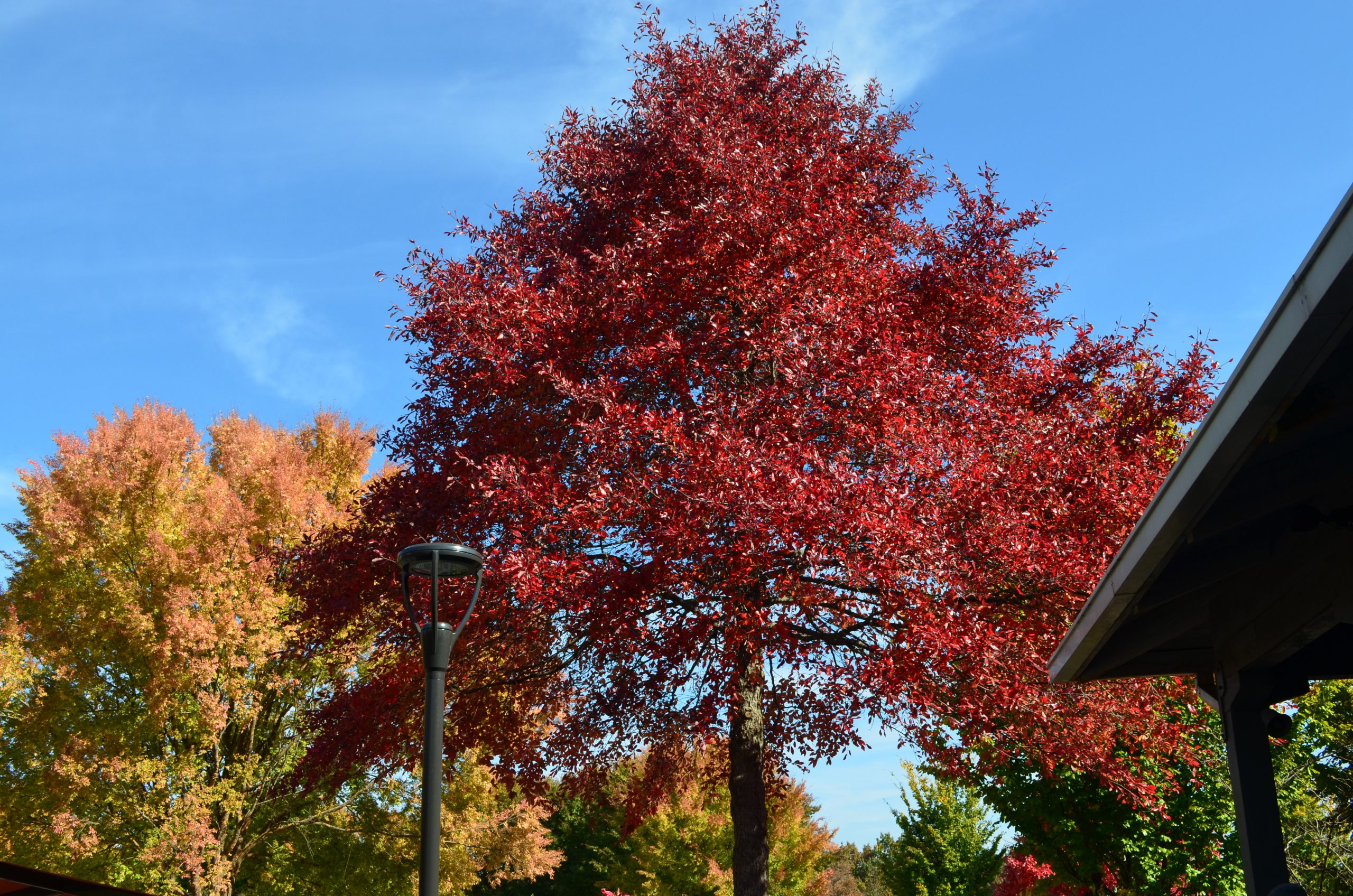
Fifteen years ago, I penned a brief article on Nyssa for HMI's TreeTalk™ publication. The present discussion expands significantly on that information and discusses the advances in Nyssa selection, evaluation, and production techniques.
Recently, I was asked what I thought of Nyssa sylvatica as a replacement for Acer rubrum by Nate Nix, sales arborist, Monster Tree Service in Athens, Georgia. The company has worked with me and offers quality work at a fair price. Nate said a local Athens residential, golf, and tennis complex, wanted to install 1,250 Nyssa sylvatica to replace the red maples that have languished. I become apoplectic when one monoculture is being replaced by another. The heartbreaker was the proposal to use a single Nyssa sylvatica cultivar. I asked Nate about at least mixing cultivars and told him I would review what I consider the best selections.
In 2019, I was involved in tree selections for our Oconee County, Georgia, four-lane connector project. We planted 761 trees along the 3.5-mile length. Over half were Quercus species. Twenty-one Nyssa were installed, all seedlings, with rag-tag, motley habits, variable fall color, and tardy recovery after transplanting. More on this project in a future article.
The local Lowe’s replaced the parking lot trees with an avenue of seedling N. sylvatica. The variation in habits and fall colors from perpetually green to brilliant orange-red speaks to the need for clonal selections. On the University of Georgia campus, a uniformly branched female seedling tree with lustrous dark green leaves, consistent brilliant red-maroon fall color, and lack of leaf spot caught my eye.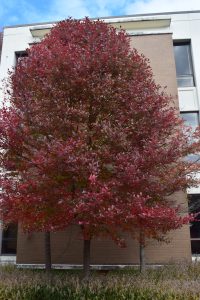 Hidden Hollow Nursery, Belvidere, Tennessee, budded it and I added one to the garden. The first year it contracted leafspot and now in the third year, I hope for better results. My most recent discovery of a unique Nyssa sylvatica occurred in June 2022, during a conference at Mount Vernon, Virginia. This female specimen is distinctly conical pyramidal in habit and the foliage lustrous dark green. Currently it is being propagated by Hidden Hollow Nursery and Moon's Tree Farm in Washington, Georgia. If worthy of introduction, it will prove a great street and garden addition where lateral space is limited. I should add that George Washington planted the species on the estate.
Hidden Hollow Nursery, Belvidere, Tennessee, budded it and I added one to the garden. The first year it contracted leafspot and now in the third year, I hope for better results. My most recent discovery of a unique Nyssa sylvatica occurred in June 2022, during a conference at Mount Vernon, Virginia. This female specimen is distinctly conical pyramidal in habit and the foliage lustrous dark green. Currently it is being propagated by Hidden Hollow Nursery and Moon's Tree Farm in Washington, Georgia. If worthy of introduction, it will prove a great street and garden addition where lateral space is limited. I should add that George Washington planted the species on the estate.
Most landscape architects, designers, and gardeners know little about Nyssa sylvatica, having been brainwashed by red maple ideology. There are eight Nyssa species worldwide, with N. sylvatica the best known and most important shade and ornamental species in North America. The species is native to Canada, Maine to Florida, west to Wisconsin, Michigan and Texas, in dry to moist habitats, including standing water. I have recorded trees in dry/rocky soil on Whiteside Mountain, North Carolina at 4,000 to 5,000’ elevation. In our Bogart, Georgia, garden, a 60’ tall female tree spreads seedlings through the 3.5 acres. I purchased the contiguous lot to preserve this magnificent 4-trunked work of art.
Nyssa sylvatica has received greater attention from nurseries with over 30 selections (see list below). Twenty years past there were less than 10 and few were commercially available. A major west coast nursery told me they could sell greater numbers, but propagation was more difficult than, for example, red maple. Nyssa sylvatica does not root from cuttings or, to my knowledge, respond to tissue culture. Winter grafting and summer budding work well. I have grown many seedlings by collecting the blue-black fruits in fall, removing pulp, floating seeds to determine viability (sinkers sound/viable), providing 90 days cold-moist stratification, often with germination (root radicle) in the cold.
The principal tree genera in nursery production in the U.S. in order of importance/numbers are Acer, Malus, Quercus, Ulmus, Cercis, Amelanchier, Tilia, Zelkova, Gleditsia, Gymnocladus, Prunus, Nyssa and Pyrus. Pyrus is on the way out due to non-native status and invasiveness. It is banned, or in the process, in several states including Ohio, Pennsylvania, and South Carolina. Fraxinus, ash, is not listed above as Emerald Ash Borer (EAB) rendered it a nonentity. Before EAB, the genus ranked with maple and oak in nursery sales.
Nyssa will continue to ascend commercially as new and better selections appear. Michael Hayman is assembling a collection of Nyssa sylvatica cultivars in Louisville, Kentucky. Mike is committed to building a genetic repository useful for evaluating cultivar performance and future breeding. His commentary on cultivars is presented below. The U.S. National Arboretum has been breeding Nyssa species for many years and has yet to release a selection. I visited the USDA's National Germplasm Resources Laboratory in Beltsville, Maryland, where hybrids of N sylvatica × N. sinensis and N. sylvatica × N. ogeche were being screened for leaf spot, canker, and leaf miner resistance. I grew N. ogeche, N. sinensis, and N. biflora; none possessing the quality attributes of N. sylvatica.
Habit is pyramidal in youth with open to densely set branches some of which are pendulous. At maturity, the horizontal branches form an irregularly rounded or flat-topped crown. The secondary branches are populated with numerous short branch spurs making pruning/climbing somewhat of an adventure. Occasionally, the lower branches, reminiscent of pin oak, sweep the ground, not exactly constituting a viable candidate for street tree use. Newer introductions like Forest Fire®, Green Gable®, Red Splyndor®, and Tupelo Tower™ develop upswept lower branches. Under landscape conditions, I estimate 30 to 50’ (60’) in height and 20 to 30’ (40’) in width. In our garden, there is a 60’ tall and 40’ wide, four trunked specimen. The National Champion is 78’ high, 95’ wide, with trunk circumference of 247”.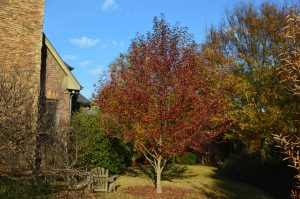
Foliage emerges later than many oaks, maples, elms, planetrees and is not fully developed until mid-May on the tupelos in the Dirr garden. Leaves range from flat/dull/matte to glossy dark green, developing fluorescent fall colors of yellow, orange, red, maroon and purple; often a kaleidoscopic mix. Without equivocation, one of America’s most consistent, beautiful trees in autumn. Leaves range in size from 3 to 6” long, 11/2 to 3” wide with entire margins, except for occasional mini lobes/teeth at the terminal, and the extended terminal apex. A fungus, Mycosphaerella nyssacola, produces black lesions on the foliage which cause premature defoliation in September-October. 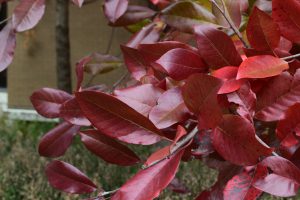
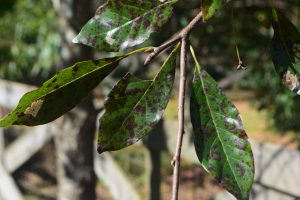 Appears more problematic in the southeast for cultivars like Afterburner™ are completely defoliated in the Dirr garden yet untouched in Mike Hayman’s Louisville trials. Red Rage™, a Hayman selection, and ‘Wildfire’, Steve Hottovy selection, are the most resistant in the Athens area. The disease is variable from year to year. In 2017, Green Gable® developed magnificent red fall color. In 2021, the same tree in our garden lost most leaves and those remaining did not color.
Appears more problematic in the southeast for cultivars like Afterburner™ are completely defoliated in the Dirr garden yet untouched in Mike Hayman’s Louisville trials. Red Rage™, a Hayman selection, and ‘Wildfire’, Steve Hottovy selection, are the most resistant in the Athens area. The disease is variable from year to year. In 2017, Green Gable® developed magnificent red fall color. In 2021, the same tree in our garden lost most leaves and those remaining did not color.
Flowers are polygamo-dioecious: bisexual (male and female parts in the same structure) and/or dioecious (male or female flowers on separate trees). Flowers open with the spring foliage; yellow-green male in many flowered rounded inflorescences;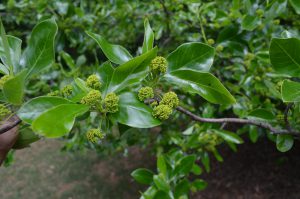 female in 2 to 4 peduncled axillary clusters. Bees are particularly fond of the flowers for nectar and pollen. It is considered a good honey tree. The fruit is an oblong, bluish black drupe, 3/8 to ½” long, ripening September-October. The fruits are sour but eaten by many species of birds and mammals. Fruits are high in crude fat, fiber, phosphorous and calcium.
female in 2 to 4 peduncled axillary clusters. Bees are particularly fond of the flowers for nectar and pollen. It is considered a good honey tree. The fruit is an oblong, bluish black drupe, 3/8 to ½” long, ripening September-October. The fruits are sour but eaten by many species of birds and mammals. Fruits are high in crude fat, fiber, phosphorous and calcium.
Nyssa sylvatica was always a difficult plant for my students to identify, particularly in winter. The ovoid, ¼” (3/8”) long buds are composed of variable colored, yellow brown to red-brown scales. The three vascular bundle traces form a cave-like entrance to the leaf scar. If still in doubt, cut the stem on the long axis and note the chambered pith. The dark gray, brown, brown-black bark on older trees is quite distinctive, often checkered into block-like/alligator hide patterns.
I believe Nyssa sylvatica is more adaptable to extremes of soil than given credence. Ideally, soils should be acid, moist, and well drained yet in the wild it grows in swamps, freshwater ponds, dry mountain ridges, abandon fields and mixed forest situations. In 2012, Bonnie and I visited the Jefferson National Forest in southwest Virginia. Mixed with oak, maple, birch, tuliptree, serviceberry, and blueberries were numerous black tupelos on the mountainsides among the rocks and rubble. Seedling trees were planted through the years at Mt. Airy Arboretum in Cincinnati, Ohio (park established in 1911; arboretum in 1930s). The soil is heavy clay, high pH and mature trees have never developed chlorosis. By observation/inference, the species is more high pH tolerant than given credence by the literature. The species is hardy from zone 4 to 9.
Nyssa sylvatica has a warranted reputation for being difficult to transplant because of the taproot and stringy root system. I mentioned 21 trees were installed along the Oconee Connector. These were ~4” diameter trees, the remnants of a seedling block that had not been root pruned. All survived but were slow to recover from transplant “shock”. In their 4th year, the leaf sizes were normal. Nurseries grow Nyssa sylvatica in grow bags, containers or, when field grown, root prune during production, thus minimizing loss. Bare root liners do not transplant well. Hale & Hines Nursery in McMinnville, Tennessee, produces beautiful trees in 15-to-45-gallon containers.
Below is a list of Nyssa sylvatica cultivars cobbled together from nursery catalogs, literature, and personal experiences.
| Afterburner® (‘David Odom’)
‘Autumn Cascade(s)’ ‘Big Momma’ ‘Carolyn’ Fire Master® (‘PRP 1’) Firestarter® (‘JFS-red’) Heavy leaf spot in Louisville. Forest Fire™ (‘The James’) Forum™ (‘NXSXF’) Green Gable™ (‘NSUHH’) Gum Drop® (‘JFS-PN Legacy 1’) ‘Hidden Hollow Dwarf’ ‘Isobel Grace’ ‘Jermyns Flame’ ‘Lakeside Weeper’ Majestic® (‘M.O.N.2’) ‘Miss Scarlet’ ‘Mount Vernon’ ‘Mt. Airy’
|
Nitro™ (‘BBN-01’)
Northern Splendor™ ‘Penwood Weeper’ ‘Red Jeanne’ Red Rage® (‘Hayman Red’) Red Splyndor® (‘NSMTF’) ‘Red Red Wine’ ‘Salem Weeper’ ‘Sheffield Park’ ‘Sheri’s Cloud’ Snow Flurries™ (‘Grechrist’) Tupelo Tower™ (‘WFH1’) White Chapel™ (‘Cherry Pie’) ‘Wildfire’ ‘Winchester’ (same as ‘Winning Colors’?) ‘Windsor’ ‘Winning Colors’ ‘Wisley Bonfire’ ‘Zydeco Twist’
|
To date, Mike Hayman has accumulated 21 selections/cultivars. I asked him for commentary on those he considered the best, based on performance in Louisville. My observations are in italics.
Mike noted it is difficult to pick the best because they vary year to year, and some haven’t been in the collection long enough to judge, but so far, using architecture/branch structure, leaf spot resistance, and fall color as criteria, these rated high.
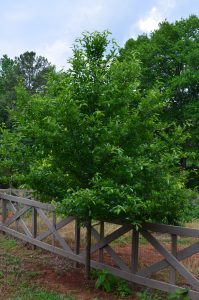 Afterburner® (‘David Odum’)- Prolific fruit producer. Usually good leaf spot residence in Louisville. Glossy leaves. High disease susceptibility in Dirr garden. Never had the opportunity to observe the rich red fall color since leaves had abscised.
Afterburner® (‘David Odum’)- Prolific fruit producer. Usually good leaf spot residence in Louisville. Glossy leaves. High disease susceptibility in Dirr garden. Never had the opportunity to observe the rich red fall color since leaves had abscised.
Fire Master® (PRP 1’)- Discovered by Phil Powell in western Kentucky, glossy leaves, smaller leaves than Red Rage®. Excellent red fall color. Good leaf spot resistance if in full sun. Female. Dirr has not grown. Observed with leaf spot in Louisville 9-13-16. 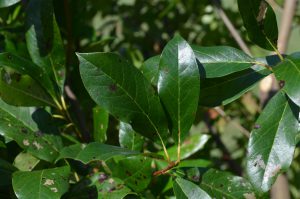
Green Gable®- Dense, upright habit, glossy leaves. Good against leaf spot. Found by Harald Neubauer, Belvidere, Tennessee. Male. Tree in the Dirr garden is upright conical-pyramidal with upswept lower branches. Fall color has been inconsistent. Great red when at its best. Terrific choice for areas where lateral space is limited.
Majestic®- Seedling of ‘Carolyn’ discovered by Ken Kazimier, Madison, Wisconsin. ‘Carolyn’ is a New Hampshire seed source so Majestic® should be very cold hardy but someone else will have to test cold limits. Little early to judge but so far doing very well in Louisville. Glossy leaves. Female. Yellow, orange, red fall color, according to Kuenzi Turf & Nursery. Dirr has not grown.
Red Rage® (‘Hayman Red’)- Big glossy summer leaf and easy to identify from the leaves. Red orange fall color usually. Found near Tell City, Indiana, in a fence row. Good against leaf spot if in full sun. Good branch architecture. Male. Excellent smaller version of the species. High leaf spot resistance in the Southeast. Consistent orange red fall color. Trees on the Georgia and Wofford College (Spartanburg, S.C.) campuses are outstanding.
‘Wildfire’- Burgundy spring foliage. Dense, wide, fast growing, almost certainly a southern seed source. Found by Steve Hottovy. Fall color sometimes. Good against leaf spot. Good architecture. Male. I have three in the garden. Fast growing and maintains a central leader. Branches are wide spreading, the lower arching. The emerging leaves are red, maturing green (May in the Dirr garden). Subsequent growth flushes still colorful. Fall color inconsistent and seldom great although in the Dirr garden and Georgia campus, trees have colored brilliant red. High resistance to leaf spot.
‘Winning Colors’ is a prolific fruit producer. Scarlet fall color. Good architecture. Good against leaf spot but not as glossy as Afterburner®. Dirr has not grown.
A few Dirr recommendations beyond Mike Hayman’s and my combined thoughts.
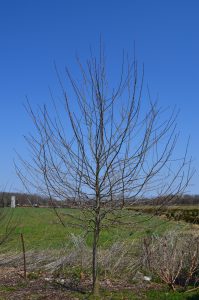 Forest Fire™ (‘The James’)- Upright oval to rounded crown, 40-50’ by 20-25’. Uniform branch structure, branches upswept. Glossy dark green leaves turn red in fall. Female. Introduced by Hale & Hines Nursery, McMinnville, Tennessee. Good leaf spot resistance on small tree in the Dirr garden.
Forest Fire™ (‘The James’)- Upright oval to rounded crown, 40-50’ by 20-25’. Uniform branch structure, branches upswept. Glossy dark green leaves turn red in fall. Female. Introduced by Hale & Hines Nursery, McMinnville, Tennessee. Good leaf spot resistance on small tree in the Dirr garden.
Nitro™ (‘BBN-01’)- Have only observed once. Large leaves, red-purple new growth. Red fall color. Listed 40-50’ high, 25-30’ wide. A sport of ‘Wildfire’, the leaves ~twice as large. Described as ‘Wildfire’ on steroids. Leaf spot resistance unknown. Perhaps like ‘Wildfire’. Introduced by Dwight Bottoms, Bottoms Brothers Nursery, McMinnville, Tennessee. Offered by Greenleaf Nursery.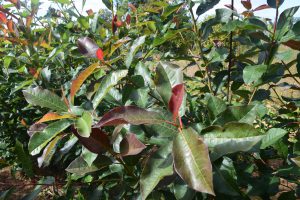
Red Splyndor® (‘NSMTF’)- Red Splyndor® maintains a central leader with upswept secondary branches forming a pyramidal-oval outline. Impressive, uniform, symmetrically branched tree. Foliage is lustrous dark green, various shades of red in autumn. Typically, clean foliage, although slight leaf spot on occasion. Sets some fruit. 50-60’ by 35-40’. Discovered by Dwayne Moon, Moon's Tree Farm. Dwayne and I work on many tree projects and currently are propagating the Mount Vernon Nyssa that was previously described.
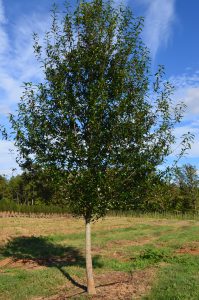
The Nyssa sylvatica story continues to unfold as new selections are made. I doubt there will ever be a perfect black tupelo. For Mike Hayman, Dwayne Moon, myself, and other arboricultural explorers, the joy is in the discovery, and numerous trees yet await our visit.